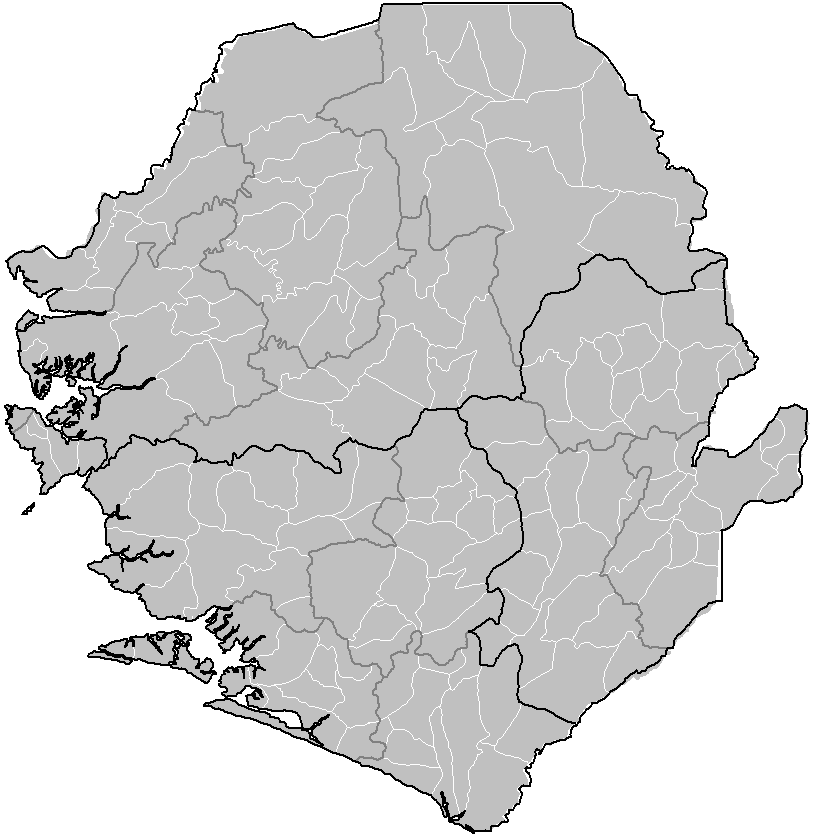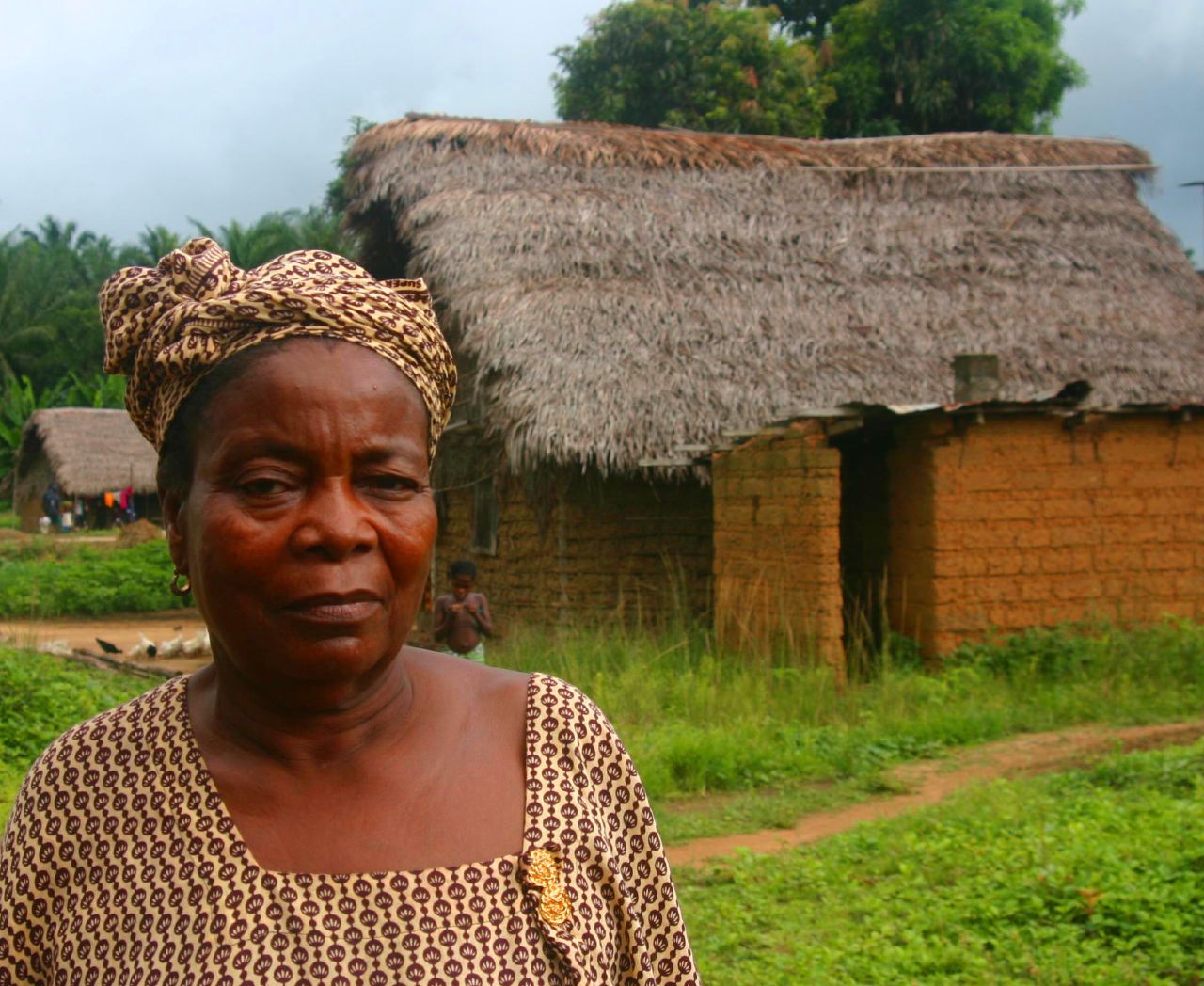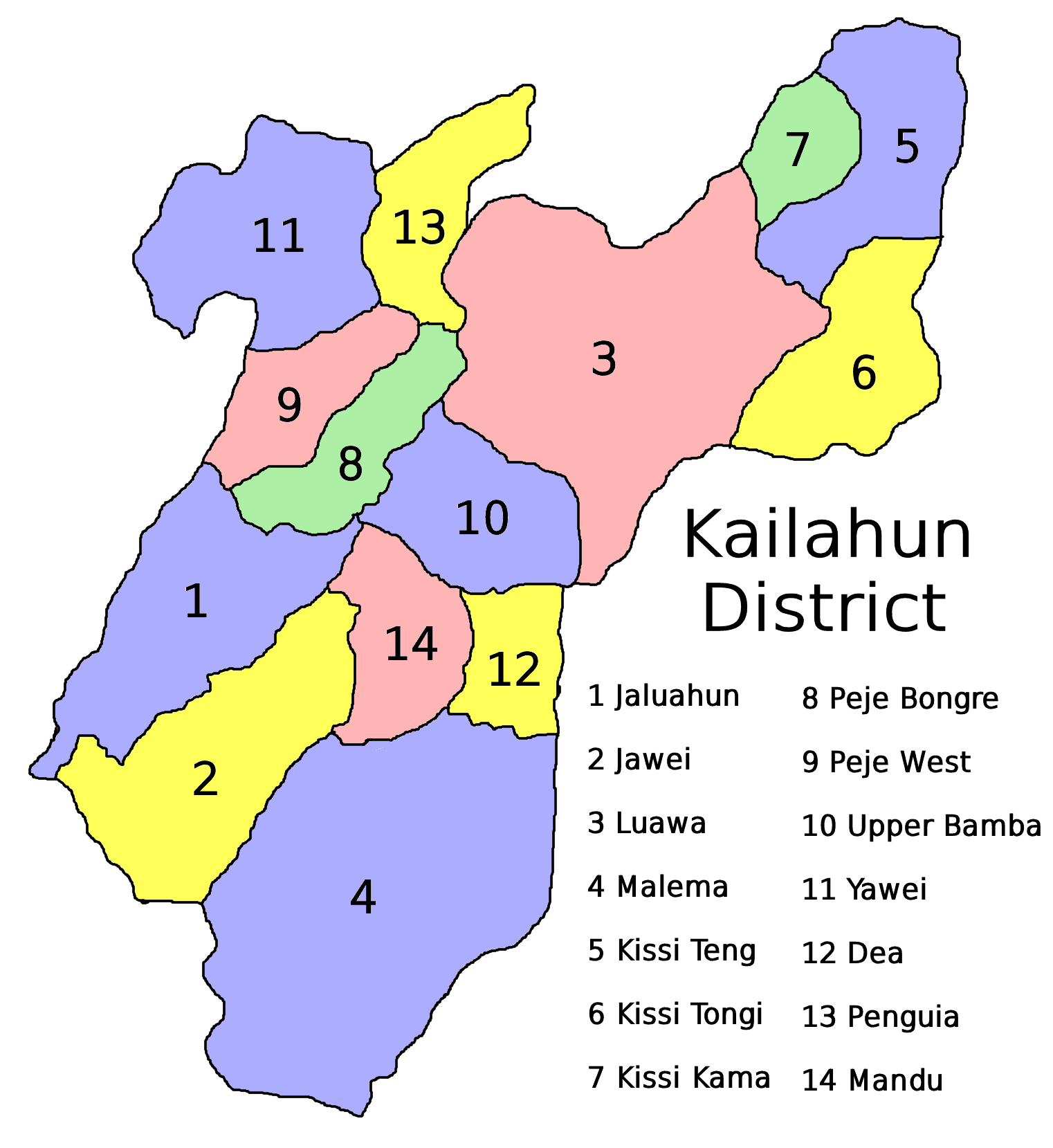|
Kenema District
Kenema District is a district in the Eastern Province of Sierra Leone. Its capital city, capital and largest city is Kenema, which is the third most populous city in Sierra Leone, after Freetown and Bo. Tongo is the second most populous city in the district. Other major towns in Kenema District include Blama and Yomboma. The district is the most populous district in the Eastern province with a population 609,873. Kenema District has an area of and comprises sixteen chiefdoms. The District of Kenema borders Bo District to the west, the Republic of Liberia to the southeast, Tonkolili District and Kono District to the north, Kailahun District to the east, and Pujehun District to the southwest. The economy of Kenema District is largely based on Farming, Diamond mining and trade. The Mende is the largest ethnic group in the district, though the district is home to a significant population of many of Sierra Leone"s ethnic groups. The population of Kenema District is majority Musl ... [...More Info...] [...Related Items...] OR: [Wikipedia] [Google] [Baidu] |
Sierra Leone
Sierra Leone,)]. officially the Republic of Sierra Leone, is a country on the southwest coast of West Africa. It is bordered by Liberia to the southeast and Guinea surrounds the northern half of the nation. Covering a total area of , Sierra Leone has a tropical climate, with diverse environments ranging from savanna to rainforests. The country has a population of 7,092,113 as of the 2015 census. The capital and largest city is Freetown. The country is divided into five administrative regions, which are subdivided into Districts of Sierra Leone, 16 districts. Sierra Leone is a constitutional republic with a unicameral parliament and a directly elected executive president, president serving a five-year term with a maximum of two terms. The current president is Julius Maada Bio. Sierra Leone is a Secular state, secular nation with Constitution of Sierra Leone, the constitution providing for the separation of state and religion and freedom of conscience (which includes freedom of ... [...More Info...] [...Related Items...] OR: [Wikipedia] [Google] [Baidu] |
Chiefdoms Of Sierra Leone
The chiefdoms of Sierra Leone are the third-level units of administration in Sierra Leone. There are 190 chiefdoms in Sierra Leone, as of 2017. Previously, there were 149. History and organisation The paramount chiefs and the ruling families in the chiefdoms were recognised and empowered by the British colonial administration when it organised the Protectorate of Sierra Leone in 1896. Tristan Reed and James A. Robinson, ''The Chiefdoms of Sierra Leone'' ''Scholar'', Harvard University, 15 July 2013, Document available online, accessed 30 April 2014 Typically, chiefs have the power to "raise taxes, control the judicial system, and allocate land, the most important resource in rural areas." The hereditary paramount chiefs and their sub-chief ... [...More Info...] [...Related Items...] OR: [Wikipedia] [Google] [Baidu] |
Chief Minister
A chief minister is an elected or appointed head of government of – in most instances – a sub-national entity, for instance an administrative subdivision or federal constituent entity. Examples include a state (and sometimes a union territory) in India; a territory of Australia; a province of Sri Lanka or Pakistan; a federal province in Nepal; an autonomous region of Philippines; or a British Overseas Territory that has attained self-governance. It is also used as the English version of the title given to the heads of governments of the Malay states without a monarchy. The title is also used in the Crown Dependencies of the Isle of Man (since 1986), in Guernsey (since 2004), and in Jersey (since 2005). In 2018 Sierra Leone, a presidential republic, created the role of an appointed chief minister, which is similar to a prime minister in a semi-presidential system. Before that, only Milton Margai had the same position between 1954 and 1958. [...More Info...] [...Related Items...] OR: [Wikipedia] [Google] [Baidu] |
Christians
Christians () are people who follow or adhere to Christianity, a monotheistic Abrahamic religion based on the life and teachings of Jesus Christ. The words ''Christ'' and ''Christian'' derive from the Koine Greek title ''Christós'' (Χριστός), a translation of the Biblical Hebrew term ''mashiach'' (מָשִׁיחַ) (usually rendered as ''messiah'' in English). While there are diverse interpretations of Christianity which sometimes conflict, they are united in believing that Jesus has a unique significance. The term ''Christian'' used as an adjective is descriptive of anything associated with Christianity or Christian churches, or in a proverbial sense "all that is noble, and good, and Christ-like." It does not have a meaning of 'of Christ' or 'related or pertaining to Christ'. According to a 2011 Pew Research Center survey, there were 2.2 billion Christians around the world in 2010, up from about 600 million in 1910. Today, about 37% of all Christians live in the Am ... [...More Info...] [...Related Items...] OR: [Wikipedia] [Google] [Baidu] |
Muslim
Muslims ( ar, المسلمون, , ) are people who adhere to Islam, a monotheistic religion belonging to the Abrahamic tradition. They consider the Quran, the foundational religious text of Islam, to be the verbatim word of the God of Abraham (or '' Allah'') as it was revealed to Muhammad, the main Islamic prophet. The majority of Muslims also follow the teachings and practices of Muhammad ('' sunnah'') as recorded in traditional accounts (''hadith''). With an estimated population of almost 1.9 billion followers as of 2020 year estimation, Muslims comprise more than 24.9% of the world's total population. In descending order, the percentage of people who identify as Muslims on each continental landmass stands at: 45% of Africa, 25% of Asia and Oceania (collectively), 6% of Europe, and 1% of the Americas. Additionally, in subdivided geographical regions, the figure stands at: 91% of the Middle East–North Africa, 90% of Central Asia, 65% of the Caucasus, 42% of Southeast As ... [...More Info...] [...Related Items...] OR: [Wikipedia] [Google] [Baidu] |
Mende People
The Mende are one of the two largest ethnic groups in Sierra Leone; their neighbours, the Temne people, constitute the largest ethnic group at 35.5% of the total population, which is slightly larger than the Mende at 31.2%. The Mende are predominantly found in the Southern Province and the Eastern Province. The Mende are mostly farmers and hunters. Some of the major cities with significant Mende populations include Bo, Kenema, Kailahun, and Moyamba. Like a majority of African nations, Sierra Leone's political parties are often tied to specific ethnic groups and have been dominated by the Mende, on the one hand, and the Temne and their long-time political allies, the Limba people (Sierra Leone), Limba, on the other. The Mende are known to typically support the Sierra Leone People's Party (SLPP), while the Temnes and Limbas are associated with the All People's Congress party (APC). History Regional warfare throughout the 19th century led to the capture and sale of many M ... [...More Info...] [...Related Items...] OR: [Wikipedia] [Google] [Baidu] |
Trade
Trade involves the transfer of goods and services from one person or entity to another, often in exchange for money. Economists refer to a system or network that allows trade as a market. An early form of trade, barter, saw the direct exchange of goods and services for other goods and services, i.e. trading things without the use of money. Modern traders generally negotiate through a medium of exchange, such as money. As a result, buying can be separated from selling, or earning. The invention of money (and letter of credit, paper money, and non-physical money) greatly simplified and promoted trade. Trade between two traders is called bilateral trade, while trade involving more than two traders is called multilateral trade. In one modern view, trade exists due to specialization and the division of labour, a predominant form of economic activity in which individuals and groups concentrate on a small aspect of production, but use their output in trades for other products ... [...More Info...] [...Related Items...] OR: [Wikipedia] [Google] [Baidu] |
Diamond Mining
Diamond is a solid form of the element carbon with its atoms arranged in a crystal structure called diamond cubic. Another solid form of carbon known as graphite is the chemically stable form of carbon at room temperature and pressure, but diamond is metastable and converts to it at a negligible rate under those conditions. Diamond has the highest hardness and thermal conductivity of any natural material, properties that are used in major industrial applications such as cutting and polishing tools. They are also the reason that diamond anvil cells can subject materials to pressures found deep in the Earth. Because the arrangement of atoms in diamond is extremely rigid, few types of impurity can contaminate it (two exceptions are boron and nitrogen). Small numbers of defects or impurities (about one per million of lattice atoms) color diamond blue (boron), yellow (nitrogen), brown (defects), green (radiation exposure), purple, pink, orange, or red. Diamond also has a very ... [...More Info...] [...Related Items...] OR: [Wikipedia] [Google] [Baidu] |
Farming
Agriculture or farming is the practice of cultivating plants and livestock. Agriculture was the key development in the rise of sedentary human civilization, whereby farming of domesticated species created food surpluses that enabled people to live in cities. The history of agriculture began thousands of years ago. After gathering wild grains beginning at least 105,000 years ago, nascent farmers began to plant them around 11,500 years ago. Sheep, goats, pigs and cattle were domesticated over 10,000 years ago. Plants were independently cultivated in at least 11 regions of the world. Industrial agriculture based on large-scale monoculture in the twentieth century came to dominate agricultural output, though about 2 billion people still depended on subsistence agriculture. The major agricultural products can be broadly grouped into foods, fibers, fuels, and raw materials (such as rubber). Food classes include cereals (grains), vegetables, fruits, cooking oils, meat, milk, e ... [...More Info...] [...Related Items...] OR: [Wikipedia] [Google] [Baidu] |
Pujehun District
Pujehun District is a district in the Southern Province of Sierra Leone. Pujehun District is one of the sixteen Districts of Sierra Leone. Its capital and largest city is the town of Pujehun . The other major towns in the district include Gandorhun, Zimmi, Gendema, Masam, Bomi and Potoru. As of 2015, the district has a population of 345,577. The district of Pujehun borders the Atlantic Ocean in the southwest, the Republic of Liberia to the southeast, Kenema District to the northeast, Bo District to the north and Bonthe District to the west. It occupies a total space of 4,105 km2 and comprises twelve chiefdoms. The population of Pujehun District is mainly from the Mende ethnic group, though minority ethnic groups are also found in the District. Pujehun District is a large Muslim majority district, though there is a significant Christian minority as well. History In 1982 the Ndogboyosoi (bush devil) War was fought in the district. Geography Pujehun District is locate ... [...More Info...] [...Related Items...] OR: [Wikipedia] [Google] [Baidu] |
Kailahun District
Kailahun District is a district in the Eastern Province of Sierra Leone. Its capital city, capital and largest city is the town of Kailahun. The second most populous city in the district is Segbwema. Other major towns in Kailahun District include Koindu, Pendembu and Daru. As of the 2015 census, the district had a population of 525,372. Kailahun District is subdivided into fourteen chiefdoms. The District of Kailahun borders Kenema District to the west, Kono District to the north, the Republic of Liberia to the east, and the Republic of Guinea to the north. The border of the district with Guinea is formed by a section of the Moa River., page 275. The total area of the district is . The population of Kailahun District is largely from the Mende ethnic group, though there are other ethnic groups with significant population in the district, including among them the Kissi, Mandingo and the Fula. The major economic activities in the district are farming, diamond mining and trade. ... [...More Info...] [...Related Items...] OR: [Wikipedia] [Google] [Baidu] |
Kono District
Kono District is a district in the Eastern Province of Sierra Leone. Its capital and largest city is Koidu, Koidu Town. Motema is the second most populous city in the district. The other major towns in the district include Yengema, Tombodu, Jaiama Nimikor and Sewafe. The district is the largest diamond producer in Sierra Leone. The population of Kono District is 505,767. Kono District borders Kenema District to the southwest, The Republic of Guinea to the east, Koinadugu District to the northeast and Kailahun District to the southeast. Kono District is divided into fourteen chiefdoms. Kono District is one of the most ethnically diverse Districts in Sierra Leone and is home to a large population of many of Sierra Leone's ethnic groups, with no single ethnic group forming a majority. Kono District population is religiously diverse among Muslims and Christians, though Muslims make up the majority of the population in Kono District. Before the civil war, Kono District had a po ... [...More Info...] [...Related Items...] OR: [Wikipedia] [Google] [Baidu] |







